Scientists in France have found how the genes of the malaria parasite adapt to become resistant to artemisinin, one of the most effective remaining antimalarial drugs. Their discovery exposes a serious problem.
Malaria is a continuous pandemic, killing over a million people each year. Artemisinin, developed by the Chinese around the time of the Vietnam War, is very effective. But resistance is an issue as the malaria parasite adapts. This is clearly not helped by the proliferation of cheaper counterfeit drugs or ones with very little active ingredient, especially in South-east Asia, a hotbed for the disease.
A tale of resistance
Malaria wasn’t just found in the tropics; until the climate cooled and the Fens were drained it was endemic in parts of Britain (and global warming may bring it back). In the 16th century, Spanish explorers in South America discovered quinine, an extract from the bark of Cinchona trees that was active against malaria. And the Jesuits brought it back to Europe. Three centuries later, seeds smuggled out of Peru enabled the cultivation of cinchona in Java, then a Dutch settlement, which greatly increased its availability and made possible tropical enterprises like the building of the Panama Canal.
But by the 1930s, some malarial parasites were getting resistant to quinine, and synthetic formulations like quinacrine were devised. After the Japanese occupied Java in 1942, this was how Allied troops protected themselves from malaria, though they did have some side-effects (your skin and urine turned yellow). Soon the malaria parasite became resistant to the common synthetic antimalarials. New synthetics came into use like mefloquine, which was first used by American troops fighting in Vietnam in 1971.
And in a roundabout way the Vietnam War that gave us our newest antimalarial drug, artemisinin. Artemisia annua had been used by Chinese herbalists The Handbook of Prescriptions for Emergency Treatments was compiled by Ge Hong nearly 2000 years ago, and mentioned qinghao, obtained from this sweet wormwood plant as a remedy for fevers. It was the North Vietnamese leader Ho Chi Minh’s appeal to China for help in finding a treatment for the malaria-ridden army that sparked a research programme involving around 600 Chinese scientists.

Until then peasants in rural areas had used hot water to make a tea from it, or simply chewed fresh plants mixed with brown sugar, as a way of treating fevers. The Chinese scientists tested it on animals, then on themselves, and found that it was better than the then current synthetic antimalarial, chloroquine. The active molecule was given the name artemisinin. Professor Youyou Tu, who headed the artemisnin team, received the Lasker award in clinical sciences in 2011 for her work.
Gold standard
Today artemisinin is the gold standard for antimalarial medications. It is still obtained from sweet wormwood, but there are plans to obtain it from engineered yeast cells, which means it could be developed in larger amounts as well as reducing the cost of the drug – a potential counter to drug counterfeiting.
But as with other antimalarials before it, artemisinin resistance has come to the forefront. It was first noticed a decade ago in Cambodia but has spread to neighbouring countries, and there are worries that it could spread further, into Africa, where most malaria cases are found (and fake medicines too).
To combat this, artemisinin – and similar molecules – can be used in association with another drug to create a combination therapy. The two molecules act differently and target different parts of the malaria parasite, so that a gene that is resistant to one drug will not be resistant to the other one. Artemisinin-based combination therapies (ACTs) have been endorsed by the World Health Organisation as a front-line treatment for severe Plasmodium falciparum malaria.
We cannot afford to let artemisinin fail. Each year, around 200m people are infected with malaria in tropical and subtropical regions of the world. Estimates vary but around 1.2m of these will die, most of them children in the poorest parts of the world, especially sub-Saharan Africa. Quite simply, this is why artemisinin matters – because it’s a matter of life and death for a great many people. And without a realistic substitute, a very serious problem.

